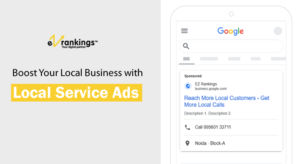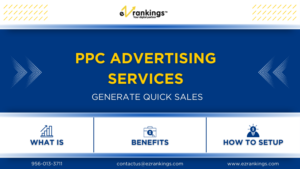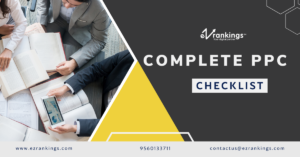How to Optimize Conversion Rates for PPC?

Conversion rate optimization (CRO) of PPC is a procedure involving transforming additional clicks on the advertisements into valuable activities, which may be leads, sales or sign-ups. It is not only about getting people to visit your site but making them take a further step towards becoming a customer once they have clicked on your advertisement.
With the current online space being an extremely competitive field where each click costs you something, conversion rates are the sole way to achieve the highest return on investment (ROI) with the campaigns you are paying to run.
Through optimization of ad copy, landing pages, and targeting, the business can help increase conversions without necessarily additional ads. Be it Google Ads or social media promotion, conversion rates should be maximised so that each click matters.
You will get to know how to analyse performance data, implement successful CRO strategies, and optimise PPC results with the correct tools in this guide. Whether it is A/B testing or audience insights, this article will take you from turning your campaigns into high converting profit makers to assets that produce quantifiable growth.
Understand What Conversion Rate Means in PPC
The conversion rate in PPC is a metric that helps to determine the effectiveness of your advertisements as they transform clicks into the desired action. It is computed with the formula: Conversion Rate = Conversions/Total Clicks x 100. This percentage indicates the number of people who did what you wanted them to do once they had clicked your ad.
There are two types of conversions, micro-conversions (e.g. form submission, downloads, and newsletter subscriptions) and macro-conversions (e.g. purchases or service sign-ups). Although the macro-conversion directly affects revenue, the micro-conversion demonstrates the indicators of the interest in the user and the engagement.
How To Improve Conversion Rate
Enhancing the conversion of PPC is all about ensuring that each of the clicks counts by optimizing each step of the user experience. Whether it is the establishment of clear objectives, the creation of compelling ad copy, or the ability to optimize the landing pages, every single step above determines the effectiveness of the visitors in converting into leads or customers.
An effective PPC conversion plan is concerned with harmonizing the message in ads, reaching the appropriate audience and constantly experimenting with the campaign components to improve effectiveness. Through content and data insights, businesses can optimise ROI, optimise ad performance, and create more valuable interactions with their customers through their paid campaigns.
Set Clear and Measurable Goals
To increase the PPC conversion rates, begin with clear goals. Regardless of whether you are generating leads, making sales, requesting demos, or sign-ups, it is important to be clear in your campaign. Direct your strategy with SMART goals Specific, Measurable, Achievable, Relevant, and Time-bound. As an example, the target is to grow the number of form entries by 20% in three months. With clear goals, you can more precisely target ads, and effectively allocate budgets, and measure campaign success more accurately.
Also, Read – PPC Strategy: The Ultimate Guide to PPC Marketing
Optimise Ad Copy for Higher CTR and Relevance
Your ad copy is the first thing that the user perceives about your brand and as such, make it count. Apply powerful CTAs like: get a free quote, book now. Make the offer, highlight the unique selling points (USPs), and customer pain points to generate relevance and urgency. Both headlines and descriptions should include target keywords to achieve better ranking of ads and increase the level of engagement. A/B test ad headlines, descriptions and CTA to see what works best with your audience.
Improve Landing Page Experience
The conversion rate of a landing page can be or break depending on how well the landing page is optimised. Pay attention to such critical aspects as quick loading, the prominent single CTA, mobile responsiveness, and trust indicators such as reviews, security symbols, and testimonials. Be minimal, keep the design simple, and graphics to the point. There is a mini landing page CRO check list to consider: concise headline, compressed form fields, attractive graphics, prominent CTA button, and trust evidence. It is important to keep in mind that the more refined and focused the landing page experience, the more likely it is to convert the visitors into paying customers.
Align Ad Message with Landing Page
The ad copy and the landing page should match consistently to gain trust and conversions. When you advertise something that includes a Free Consultation, be sure that your landing page headline captures this. This message match will reassure the users that they have been at the correct place and lower bounces. Seeing continuity of language, tone, and promise, users have more chances to remain involved and conduct the action they are supposed to. By matching your advertisement message with your landing page message, you create a sense of credibility, increase user experience, and improve overall PPC performance.
Also, Read – A Complete PPC Checklist – Improve Your Ad Performance
Use Ad Extensions to Increase Engagement
The extensions of your ad are effective means that increase the visibility of your ad and contextualize it to the potential customers. Such extensions as call extensions, sitelink extensions, location extensions, and structured snippets can be used to present some extra information, such as contact details, product categories, or offers. They increase the interaction and informational content of your ads and in many cases the click through rates. Extensions can convert intent to purchase and drive qualified traffic as they provide users with several engagement points.
Implement Advanced Targeting and Audience Segmentation
It is critical to ensure precise targeting to increase the conversion efficiency of PPC. Target the users most adequately by using geographic, demographic, and device-based targeting. Refine reaches by creating audience lists, like remarketing, in-market, or custom intent groups. Segmenting audiences allows you to target ad messages to particular behaviours or needs making them more relevant and more likely to convert. Targeting narrowly will not only enhance ROI but will also minimize wastage of money. Targeting means that your advertisements will reach individuals with the highest likelihood of delivering a response and turning into a conversion, and enhances your campaign on all platforms.
Conversion Tracking and Analytics
Without proper tracking, optimization is not possible. Add conversion tracking to Google Ads and combine it with Google Analytics to monitor such crucial indicators as CPC, CTR, bounce rate, and conversion rate. Such reflections show what is working and areas that need to be improved. Use heatmaps and session records to know what is causing friction using tools like Hotjar. Through such analysis, you are able to make more appropriate decisions, revise bids, and optimize your strategy to get superior performance. Monitoring is used to create accountability and also it leads to the continuous improvement of PPC campaigns.
Use A/B Testing to Refine Campaign Elements
A/B testing is one of the most effective ways of improving the PPC performance. Test various ad copies, landing page layout, the position of the CTA button and key phrases to determine the one that would work best. The slightest changes may result in considerable lifts in conversion rates. Each component needs to be tested individually to attain explicit and practical outcomes. Periodic testing can also gradually make your campaigns efficient using real user data, which will lead to stronger engagement, reduced cost per acquisition and more effective use of your advertising budget.
Optimise Bidding and Budget Allocation
Conversions can be influenced a lot by proper budget management. Compare the bidding strategies (manual and automated) to determine which one fits your objective. Smart Bidding capabilities like Target CPA, Target ROAS and Maximize Conversions are features of Google that leverage machine learning to achieve better results. Periodically check campaign performance and reassign budget to the highly-performing keywords or ad sets. The result is that you are only spending money on clicks that are most likely to be converted, enabling you to have as many clicks as possible and hence higher efficiency and better overall return on ad spend (ROAS).
Re-engage Lost Visitors with Remarketing
Remarketing campaigns help in the reintroduction of users who had shown interest but were not able to convert. Implement display remarketing to attain universal visibility, dynamic remarketing to conduct personalised product advertising, and RLSA (Remarketing Lists for Search Ads) to attain search-based re-engagement. Recommendations to repeat visitors: personalized adverts can be displayed to those visitors who already showed some interest in it hence convincing them to make the move. One-to-one remarketing improves brand awareness, increases the chances of conversion, and maintains your advertising budget with the warm audiences of high intent.
Analyse and Refine Regularly
PPC conversion optimization is not an event that occurs once but a continuous process. Conduct monthly performance reviews to understand what is performing and what is not. Keep on track of the seasonal changes, market forces and rivalry to be on the leading edge. Optimize on ad strategy refining, creative refining, and intelligent budget allocation, based on analytics and user feedback insights. The regular review of PPC campaigns will make them competitive, cost-efficient, and conversion-based, which will ensure long-term growth and stability of the business in the ROI.
Conclusion
In conclusion, the most effective method to maximise PPC conversion rates is a smart mix of optimisation and utilisation of data, message consistency, and never-ending testing. Aligning the ad copy with the content on the landing page, setting measurable goals and measuring performance metrics, companies can transform regular campaigns into powerful lead-generation machines. Any slight modification e.g. extension of ad and remarketing contribute to the interaction and higher ROI.
At EZ Rankings – best PPC Company, we are the experts of building high converting PPC campaigns that will achieve your business goals. We have a certified team of PPC that continuously checks, tests and optimizes every aspect of it ensuring that there is a higher lead, less cost and higher ROI. Get in touch with us now to see how we can help you to make the most out of your PPC and make certain that your business will achieve long term success that is quantifiable.
FAQs
What is a good conversion rate for PPC?
The average good PPC conversion rate depends on the industry of operation but generally speaking, a 3%-5% is a good performance. Nevertheless, the best campaigns usually have conversion rates of over 10% when they are optimised. Other aspects such as relevance of ad, experience on a landing page, targeting, and quality of offers contribute hugely to success. It is more about pursuing benchmarks but having a constant improvement of your own performance based on testing, data analysis, and strategic changes that are specific to your own goals and audience behaviour.
How do I track PPC conversions?
To monitor PPC conversions, you may establish conversion tracking in tools such as Google Ads and connect it with Google Analytics. This assists in tracking major activities like form submissions, purchases, downloads or sign-ups. Every conversion is counted once a user achieves the intended purpose by clicking on your advertisement. Tracking pixels, tags, and UTM parameters can also be used to get a deeper insight. The analysis of such metrics as CPC, CTR, and conversion rate can help to find out what is driving the results and what should be optimised to achieve higher ROI.
How often should I optimize my PPC campaigns?
The PPC campaigns must be optimised on a regular basis, preferably weekly or at least every other week. Regular reviews will enable you to recognize trends, drop a poor performing keyword, change bids and update ad creatives to perform. Nevertheless, significant structural adjustments are to be done once sufficient information is gathered, which is normally, two to four weeks. Monitoring constantly keeps your campaigns in line with the shifting behaviour of your audience, the seasonal factors and any changes in the competitors.
What factors affect PPC conversion rates the most?
The conversion rates of PPC rely on several important factors such as the relevance of the ad, the quality of landing pages, the accuracy of the targeting, or the clarity of the call-to-action. Once the message of your ad matches the intent of the user and the landing page fulfills that promise, then the conversion rates will be much higher. Additionally, the following factors are important as well: page load speed, trust signals (such as testimonials or badges), and mobile responsiveness.






